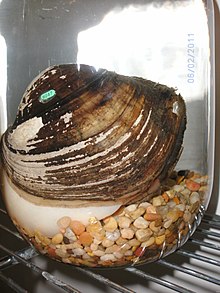| Lampsilis cardium | |
|---|---|

| |
| Scientific classification | |
| Domain: | Eukaryota |
| Kingdom: | Animalia |
| Phylum: | Mollusca |
| Class: | Bivalvia |
| Order: | Unionida |
| Family: | Unionidae |
| Genus: | Lampsilis |
| Species: | L. cardium
|
| Binomial name | |
| Lampsilis cardium Rafinesque, 1820
| |
Lampsilis cardium is a species of freshwater mussel in the family Unionidae, the river mussels. It is known commonly as the plain pocketbook.[2] It is widespread in eastern North America, where it is native to the Mississippi River and Great Lakes drainage systems.
All Unionidae are known to use the gills, fins, or skin of a host fish for nutrients during the larval glochidia stage. Lampsilis cardium accomplishes this by having the inner sides of its mantle flaps marked with longitudinal stripes, resembling a small fish of the genus Notropis. When these are attacked and ruptured by a striking predator fish, especially Micropterus coosae, the mussel larva is released into the gills of the host fish where it feeds and develops.[2][3]